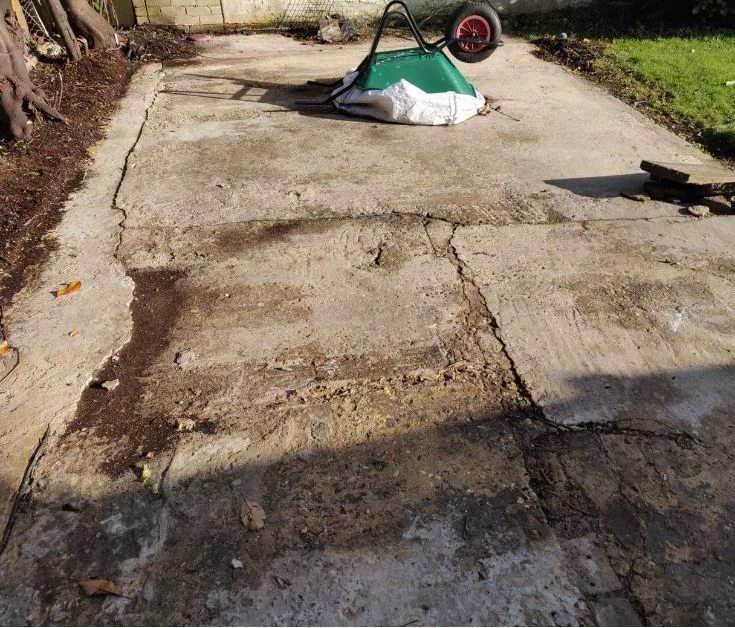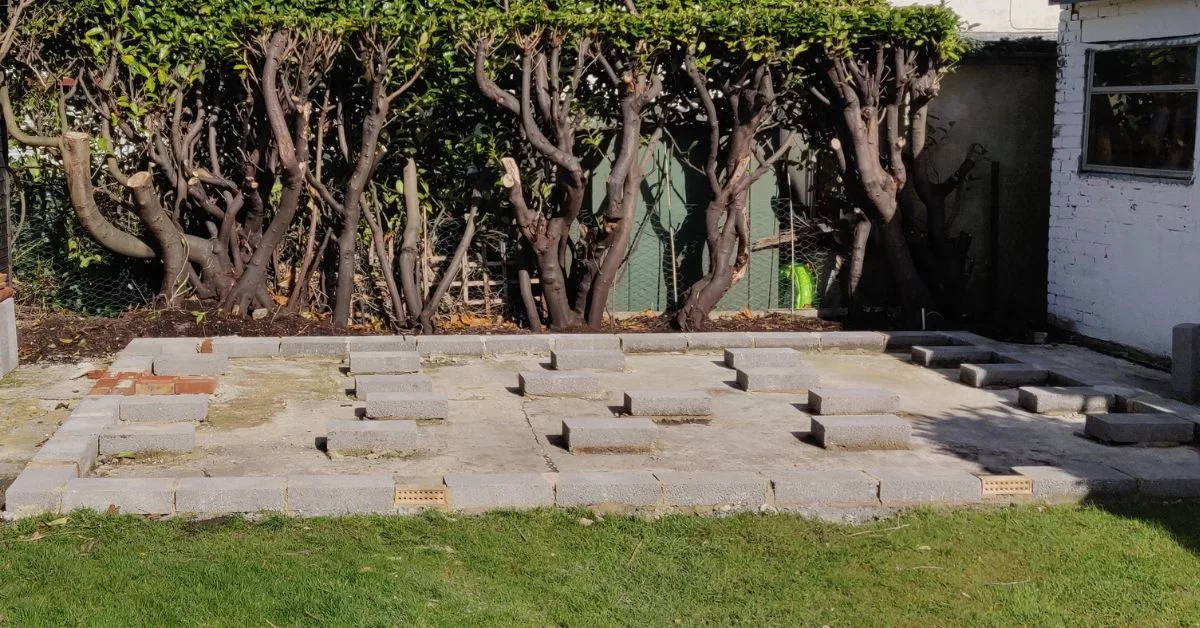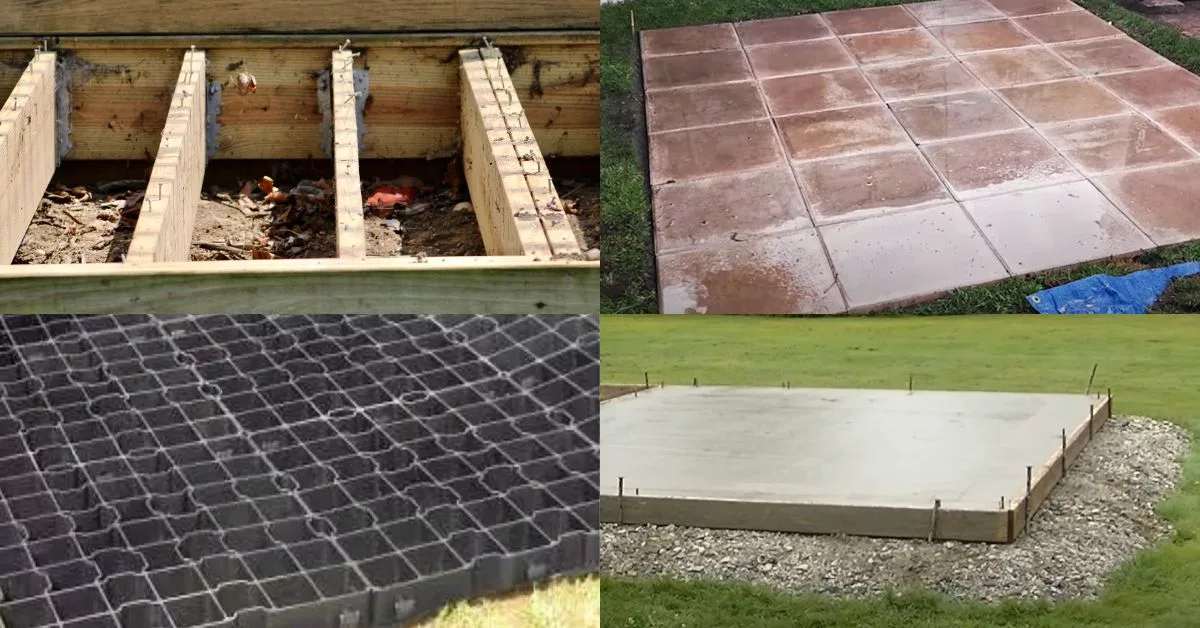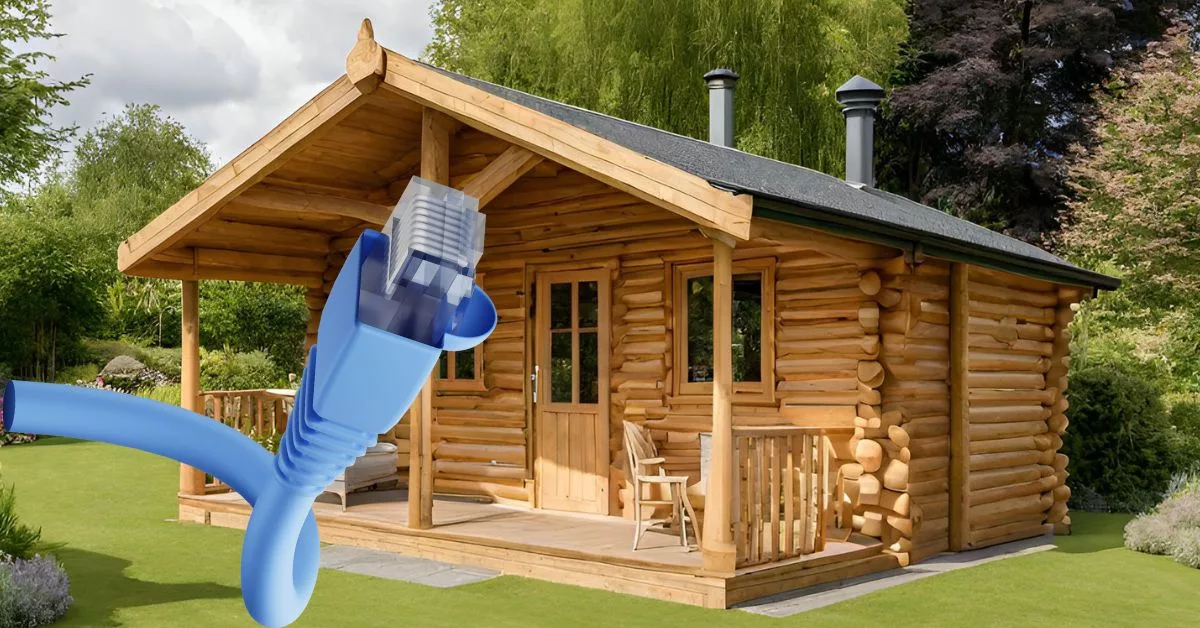The short answer is that the best base for most garden log cabins is as long as it is sturdy and not likely to start sinking in the ground, it doesn’t really matter which base you use.
The other really important thing is that the base is completely level. This can be achieved using concrete, slabs, wood and plastic ‘eco’ bases.
How I Built My Log Cabin Base
The first log cabin I built was on the concrete base where my old brick shed originally stood. Unfortunately, the concrete base was a little smaller than the cabin I was going to assemble, and the base had also subsided slightly and needed levelling.

How To Level An Existing Concrete Base
I spoke to some builders about my options for making the concrete base larger and level. One builder suggested using a self-levelling concrete, which the 2nd builder pooh-poohed, saying it wasn’t suitable for the base of a garden cabin.
The 2nd builder suggested that slabs or bricks could be laid on top of the concrete base and cement used to level them off. The slabs and bricks would only be required where the cabin wall foundation beams and the floor bearer beams would sit on the ground.
Using bricks or slabs sounded like a good idea to me, as I could do that myself, and it would also be a relatively cheap option.
I checked out a couple of YouTube videos on how to go about laying concrete blocks on a concrete base, which didn’t seem too difficult.
No products found.
The trickiest part was making sure that the blocks were level. Again, there are many videos on YouTube with tips and tricks for getting bricks perfectly level.
Because my cabin is raised up on blocks from the concrete base, I had to fit a couple of air bricks to ensure that moisture didn’t build up under the cabin and cause dampness.
The air bricks and the other concrete bricks that the cabin wall sits on were painted using the wood paint that I used on the external cabin walls.
To ensure the air was flowing freely under the cabin, I didn’t lay a solid line of bricks for the floor bearers to sit on, I left gaps. This also had the added benefit of saving me some money, as I didn’t need so many bricks.

I wasn’t sure my existing concrete base had damp proofing, so I put some damp-proof material on the bricks before building the cabin.
TOP TIP:
Make sure that the base your cabin goes on is completely level. The slightest difference in height will cause big problems. If you start to assemble your cabin on an uneven base, the logs won’t fit together properly, and the problem amplifies the further you progress.
No products found.
It should also be noted that external bases for sheds are built on a slight slant so that water will run off. A garden log cabin base should be completely level.
How To Make An Existing Concrete Base Wider
My existing concrete base was about a foot narrower than the cabin that would go on top of it. Both the builders I spoke to said the best option was to dig out the lawn a foot and fill it with concrete.
I considered using some concrete slabs to extend the base, but they would need some foundation under them to ensure they stayed in place and didn’t sink into the ground. I felt that just filling a hole with concrete sounded like the better option, rather than using slabs.
Back to YouTube on how to make a concrete base. Again, this was actually quite simple to do. I used a wheelbarrow and spade to mix the cement and sand to make my concrete. I dug out a foot from the concrete base and about 6 inches down and filled it with the concrete mix. I wasn’t too concerned about levelling as I would do this with the concrete blocks.
I’d say that extending the base and making a level base using concrete blocks probably took me about two days at most. I probably spent half a day watching YouTube videos, buying the stuff I needed, and the rest of the time actually doing the work….and rectifying mistakes.
Learning From Mistakes
I screwed up a couple of times building my cabin base
- Incorrect measurements – Stupidly, when I was measuring my base out, I used the inside measurements of the cabin and didn’t take into account the thickness of the cabin wall foundation beams. This meant my base was too small. I had to knock out the bricks at the back and one side and shift them out a few centimetres………very annoying.
No products found.
- Not level – As I’ve said a few times now, getting your base level is so important. I got my cabin wall foundation base level, but when I came to lay the floorboards, some of the bricks were clearly not level as the bearer beams wouldn’t lay flat. I ended up heavily sanding down some of the bearer beams so they were level when laid on the uneven bricks.
- Gaps – Don’t leave any gaps (apart from the air bricks) between the bricks that the cabin walls sit on. After a few months of completing my cabin, I kept hearing rustling noises coming from under the floor. Those gaps had become little doors for mice. I had to set some mouse traps and once I was sure there were no mice left under the cabin, I sealed all the gaps with cement.
Different Log Cabin Bases
Above, I’ve talked about how I used the concrete base my old shed was built on. But, before I decided to knock down the old shed and build a cabin in its place, I was looking at putting the cabin at a different location in the garden, which was just a lawn. Below are notes on my research into the various different types of garden log cabin bases.
I have no first-hand experience on the bases listed below, but hopefully, my notes will help others. If you have any real-world experience with the base types listed below, please leave a comment.
Slabs As A Log Cabin Base
Using slabs as a cabin base was my preferred option when I was initially looking at the various cabin base types. I have previously laid a slab base for my garden shed, so I have had some experience.
No products found.
The benefits of using concrete slabs:
- Laying slabs as a base was something that I could do myself. I didn’t need to get a builder to do the work for me.
- Slabs are relatively cheap. I don’t think it’s necessary to cover the entire base area with slabs, which would save on the number of slabs required.
- Laying slabs doesn’t require any special tools or equipment
- Slabs come in a number of different sizes, making it easy to get the correct size base for the cabin I was going to buy.
- Concrete slabs are pretty strong and last a very long time.
The downside of using concrete slabs as a cabin base:
- They’re f**king heavy. I built a base for my garden shed a few years back using concrete slabs and remember them being super heavy. This makes them hard to work with, and unless you want to damage your car, it will probably mean a few trips to the DIY store or arranging a delivery.
- Concrete slabs can crack in cold conditions. I’m guessing this probably isn’t a good thing with a heavy log cabin sitting on top.
Plastic Base For a Log Cabin Base
Many of the online log cabin suppliers sell a plastic grid base that snaps together to create a base. You then fill it with gravel to give it strength and stability. I did consider this type of base, but for no real good reason, I just felt they weren’t going to be as good as the other base types.
No products found.
The Pros of a plastic grid base
- It looks very easy and straightforward to install. However, some groundwork is required to make sure the plastic base sits level on the ground.
- The cost of the plastic grid bases seems to vary considerably. Some work out cheaper than using slabs and others are quite a bit more expensive. Also, you need to buy pebbles \ gravel to fill the grids, adding additional cost.
- The fact that many log cabin suppliers sell them must mean that they work.
Cons of using a plastic grid base for a log cabin
- I think these bases are probably fine for fairly lightweight garden sheds, but my cabin weighs in at just over 2 tons, and I just felt that a plastic base wouldn’t be up to the job.
Wooden Frame As A Log Cabin Base
A wooden frame base for a log cabin is very popular. I have a friend who has a wooden frame for his cabin’s base, and it has worked perfectly for about eight years.
No products found.
Pros of wooden frame base
- Tried and tested base for log cabins
- Wood is the most environmentally friendly type of base you can get.
- As long as the wood making up the frame has been pressure-treated, it will last for years.
- A wooden frame can be the cheapest option for a base, especially if you build it yourself.
- If in the future you decide that you don’t want a cabin any longer, getting rid of a wooden frame base is much easier than breaking up a concrete base and disposing of it.
Cons of a wooden frame base
- Unfortunately, I’m not a carpenter and didn’t think I’d have the skills necessary to make a sturdy wooden base.
I’m not sure there are any other significant downsides to having a wooden frame base…….I guess that’s why they are such a popular option for so many people.
Concrete Base For A Log Cabin
A concrete base is another super popular option for building log cabins on. As long as the concrete base has been properly installed, it will last a lifetime.
No products found.
Benefits of a concrete base
- A concrete base will outlast the log cabin that’s on top of it.
- Like timber frames, concrete bases are a tried and tested type of base used for garden log cabins.
Negatives of a concrete base
- I’ve never laid a concrete base before, and from what I saw online, it can be quite tricky to get the concrete level. I’d need to get a man in to do the job properly.
- Equipment: I don’t have the equipment required to make a concrete base. Things like a cement mixer, wooden boards, etc. The time I hired or bought all that stuff, it would end up being expensive.
- One of the pros of concrete is that it is very durable and lasts forever; this also makes it a negative as it takes considerable time and effort to break and get rid of a concrete base if required in the future.
Conclusion: Garden Log Cabin Bases
The four main types of base I’ve mentioned above will all probably be fine for most log cabins.
If you have an extra large and heavy cabin, then it is probably worth spending some time researching the best options. Also, if you live in an area that’s not your ‘typical’ British garden, e.g. prone to flooding, unusual soil type etc, then spend some time making sure you go with the most suitable type of base.
No products found.





